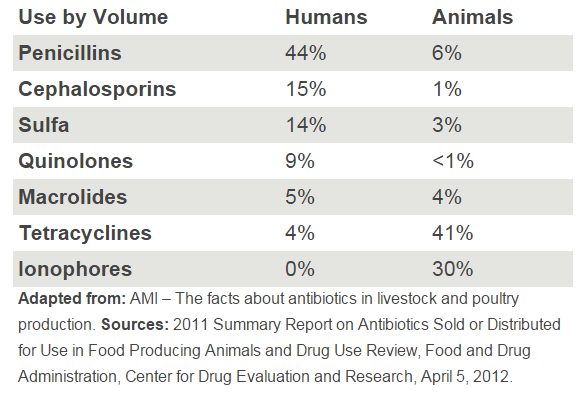Is Antibiotic Use in Animals a Concern?

Do consumers really need to be worried about antibiotic use in livestock?
By: Amanda Blair, Associate Professor & SDSU Extension Meat Science Specialist
Consumer Report: Antibiotics in meat & poultry
A report released by a group of six consumer interest, public health and environmental organizations raised questions about the use of antibiotics in meat and poultry products offered at 25 of the nation’s largest fast food and fast casual restaurants. The report, entitled “Chain Reaction – How top restaurants rate on reducing use of antibiotics in their meat supply” provides grades to restaurants depending on their ‘Antibiotic Use Policy’. While very few of the restaurants surveyed in the report received high marks (indicating they source a majority of their meat from animals raised without regular use of antibiotics) the report suggests that antibiotic use in animals contributes to the issue of antibiotic-resistant bacteria. The report then maintains that when livestock producers administer antibiotics routinely it contributes to the “worsening epidemic of resistance” and “that antibiotics may not work when we need them most: when our kids contract a staph infection or our parents get a life-threatening pneumonia”. In essence this report blamed the U.S. livestock and meat industries for the global problem of antibiotic resistance, implying that misuse of antibiotics in livestock is necessary due to poor management practices.
Concerns With the Report
Unfortunately this report contains a mixture of misinformation and facts with regards to the use of antibiotics in livestock and poultry production, thereby adding to the confusion of the consumer. When discussing the role of the livestock and meat industries in the development of antibiotic-resistant bacteria there are several important points to keep in mind:
Antibiotics used for growth promotion are being phased out
Only 13% of antibiotics in the livestock industry are used for growth promotion and the practice is being phased out. At the request of FDA, companies that produce antibiotics for animal use have committed to withdraw their products for growth promotion use by December 2016.
Feed-grade antibiotic use has been reclassified
The FDA guidance will also change the classification of “medically important” feed-grade antibiotics from the current over-the-counter designation to the Veterinary Feed Directive designation. Ultimately these medications can still be used for prevention, control and treatment of illness in animals but their use must be approved by a licensed veterinarian; similar to the way human medications are prescribed.
Human antibiotic overuse is a concern
Issues surrounding antibiotic use and development of resistant bacteria are extremely complex and involve both human and veterinary use. While the media focus tends to be on the use of these drugs in animals, a report in the New England Journal of Medicine by officials from the CDC and IMS Health found that U.S. doctors are prescribing enough antibiotics to treat four of every five Americans every year and concludes that antibiotics are being overused in humans. A 2013 CDC report found that half of the prescriptions given to people are unnecessary.
Limited overlap between human & animal antibiotic use
There is limited overlap between the antibiotics provided to humans and those given to animals.
Waiting period required before animal processing
A strict withdrawal or “waiting” period is required following administration of an antibiotic before that animal can be processed and enter the food chain. The USDA Food Safety and Inspection Service conducts a monitoring program to ensure that no unsafe residues are detected in meat and poultry.








